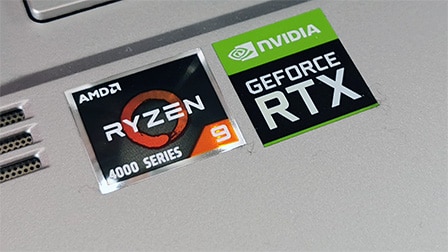Two weeks have passed since the official debut of the AMD Ryzen 4000 series processors for notebook systems, models based on Zen 2 architecture and built with 7-nanometer production technology that integrate a Vega family GPU inside. Proposed in U versions with TDP up to 15 Watt and H with TDP up to 45 Watt, these processors are characterized by offering declinations equipped with up to 8 cores inside: a nice leap forward compared to the previous generation which as a maximum offered models with 4 cores.
[HWUVIDEO=”2912″]ASUS Zephyrus G14: 8 cores with AMD Ryzen 4900HS[/HWUVIDEO]
In the coming days the first notebook models based on these processors will be on sale, with availability in volumes that will undoubtedly be affected by the pandemic from COVID-19 that is characterizing everyone's life. Regardless, however, we will see a large number of models that will debut on the market in the coming months: the same AMD has in fact confirmed that the Ryzen 4000 processors have garnered the interest of many manufacturers who are preparing the debut of their own solutions.
Among these is ASUS, a company that already at CES 2020 in Las Vegas last January had shown a very interesting product based on Ryzen 4000 CPU and intended for a demanding audience, composed of those who seek compactness in a portable PC but they want to buy a powerful machine that can also be used for gaming. We are talking about ROG Zephyrus G14, the model we analyze in this article and which is the first notebook with Ryzen 4000 CPU to enter our editorial staff.
ROG Zephyrus G14: a powerful yet compact notebook for the gamer
Zephyrus G14 comes with a design that is undoubtedly peculiar: the 14-inch screen, in the version in our possession, has a white finish but is also available as an option in black. The remaining structure has a silver color, or alternatively black in the other available finish. ASUS has chosen to equip this notebook with a magnesium aluminum alloy structure for both the upper and lower parts, reserving a plastic structure for the screen cover. The result is a considerable overall rigidity in spite of the thickness which is contained in 17.9 mm with a weight of 1.6Kg. In the area immediately below the keyboard, that of the touchpad and where they generally place their palms in the typing, a honeycomb structure has been developed inside the chassis that allows to further increase the overall rigidity.
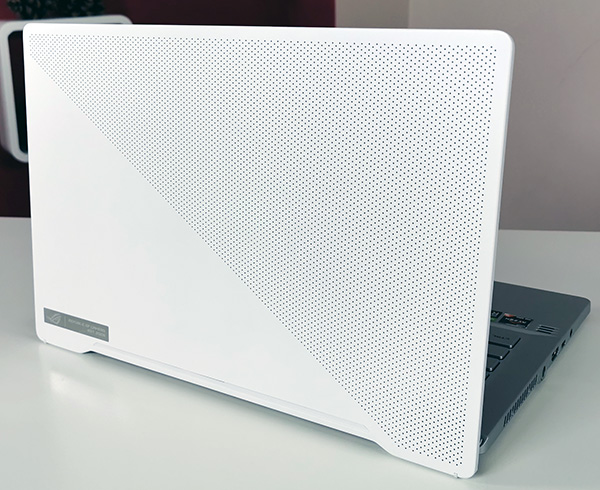
At CES we had the opportunity to see in operation a version of this notebook equipped with the AniMe Matrix LED display: it is a series of programmable LEDs mounted on the panel that covers the screen, which can display text or images according to the preferences of the user. The sample of notebooks in our possession does not implement this function, which is provided only in some versions that will arrive on the market only later: the perforated surface remains for about half of the development, a finish that even without the LEDs allows you to characterize in Zephyrus G14 marked way without necessarily having to resort to LED games.
Template | ASUS Zephyrus G14 |
| screen | 14 inches |
| resolution | 1920×1080 pixels IPS, 120Hz, 100% sRGB Pantone Validated |
| CPU | AMD Ryzen 9 4900HS |
| GPU | NVIDIA GeForce RTX 2060 Max-Q |
| Msystem memory | 16GB (2x8GB), DDR4-3200 |
| Storage | SSD 1TB |
| Connection ports | 1 USB 3.2 Gen2 Type-C with Display Port and Power delivery 1 USB 3.2 Gen2 Type-C 2 USB 3.2 Gen1 Type-A 1 HDMI 2.0b |
| Bluetooth | 5.0 |
| Battery | 76Wh |
| O.S. | Windows 10 Home |
| Wifi | 802.11ax 2×2 (WiFi 6) |
| Photoroom | – |
| Weight | 1.6Kg |
| dimensions | 32,4×22,2×1,79cm |
Looking at the technical characteristics of the notebook sample analyzed in this article, it is easy to deduce that it is a very powerful model starting from the AMD Ryzen 9 4900HS processor. The paired GPU is an NVIDIA GeForce RTX 2060 Max-Q model, chosen on the ideal card thinking of using a screen with a resolution of 1920×1080 pixels. The 16 Gbytes of DDR4-3200 memory in dual channel configuration are more than suitable for any need for personal productivity while 1TB capacity SSD adopts PCI Express interface. The battery is very large, 76Wh, and this leaves room for a very high overall autonomy in spite of the powerful components used. The network subsystem, finally, sees the use of a WiFi 6 solution therefore aligned with what is offered by the latest notebooks based on the latest generations of Intel platforms.
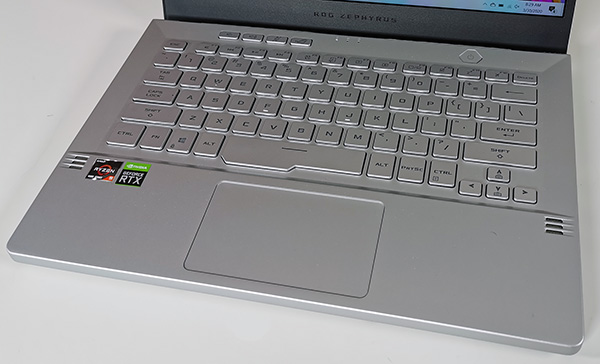
ASUS offers 4 distinct versions of this notebook that differ in processor, video card and screen characteristics:
- GA401IV: AMD Ryzen 9 4900HS or Ryzen 7 4800HS processor; NVIDIA GeForce RTX 2060 Max-Q video card; 2560×1440 60Hz or 1920×1080 120Hz / 60Hz panel with Adaptive Sync support
- GA401U: AMD Ryzen 9 4900HS or Ryzen 7 4800HS processor; NVIDIA GeForce GTX 1660 Ti Max-Q video card; 2560×1440 60Hz or 1920×1080 120Hz / 60Hz panel with Adaptive Sync support
- GA401II: Ryzen 7 4800HS or Ryzen 5 4600HS processor; NVIDIA GeForce GTX 1650 Ti video card; 1920×1080 120Hz / 60Hz panel with Adaptive Sync support
- GA401IH: Ryzen 7 4800HS or Ryzen 5 4600HS processor; NVIDIA GeForce GTX 1650 video card; 1920×1080 120Hz / 60Hz panel with Adaptive Sync support
The version we analyzed is GA401IV, with Ryzen 9 4900HS processor and panel with a resolution of 1920×1080 pixels.


Zephyrus G14 has compact dimensions but does not for this renounce to a very rich endowment, also as regards the possibility of connection with external peripherals. On the right side we find two USB 3.2 Gen1 Type-A ports and one USB 3.2 Gen2 Type-C; on the left one there is an HDMI 2.0b connector for a second screen and a second USB 3.2 Gen2 Type-C port which is equipped with Display Port support to operate as a connection to a secondary screen as well as power delivery. This implies that it is possible to power the notebook, recharging its batteries, even using a traditional smartphone power supply with Type-C connection of maximum 65 Watts. The power supplied is not sufficient to balance the instantaneous consumption of the notebook when the CPU and GPU are used to the maximum, but it can be a valid option when you do not have the bulky 180 Watt power supply provided.
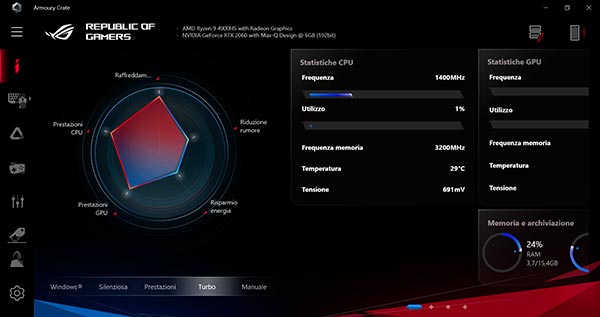
ASUS Armory Gate
Keyboard, with backlight, and touchpad pick up the color of the top of the notebook; are components of good workmanship, with the keys that have a slightly higher stroke than that typical of thin notebooks but which in this case is appreciable thinking of using a Zephyrus G14 as a gaming machine. Near the screen there are dedicated buttons for the volume of the audio, the enabling of the microphone and a ROG key that regulates the opening of the Armory Gate panel, with which you can configure the parameters of the notebook directly from the operating system. The power button integrates a fingerprint sensor inside, useful for authenticating directly to the operating system: there is no webcam, which ASUS indicates as an optional accessory.
Ryzen 9 4900HS processor: 8 cores and 35 Watt TDP
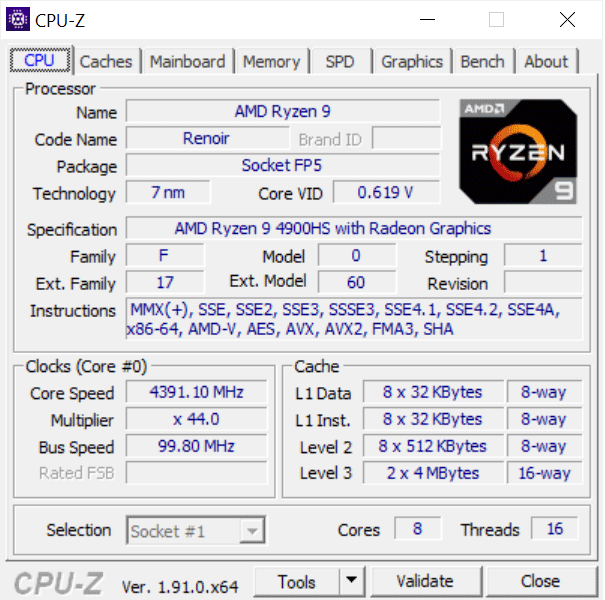
The AMD Ryzen 9 4900HS processor used in this notebook is AMD's top of the range proposal among the new 7-nanometer Ryzen CPUs. The technical specifications are those of the Ryzen 9 4900H model in terms of the number of cores and threads, with two significant differences: slightly lower clock frequencies compared to a TDP that drops to 35 Watts against the 45 Watts of the H model.
Template | Core | Threads | Clock | Boost clock | TDP | GPU cores | GPU clock | Cache |
| Ryzen 9 4900H | 8 | 16 | 3,3GHz | 4,4GHz | 45W | 8 | 1.750MHz | 12M |
| Ryzen 9 4900HS | 8 | 16 | 3GHz | 4,3GHz | 35W | 8 | 1.750MHz | 12M |
| Ryzen 7 4800H | 8 | 16 | 2,9GHz | 4,2GHz | 45W | 7 | 1.600MHz | 12M |
| Ryzen 7 4800HS | 8 | 16 | 2,9GHz | 4,2GHz | 35W | 7 | 1.600MHz | 12M |
| Ryzen 5 4600H | 6 | 12 | 3GHz | 4GHz | 45W | 6 | 1.500MHz | 11M |
| Ryzen 5 4600HS | 6 | 12 | 3GHz | 4GHz | 35W | 6 | 1.500MHz | 11M |
| Ryzen 7 4800U | 8 | 16 | 1.8GHz | 4,2GHz | 15W | 8 | 1.750MHz | 12M |
| Ryzen 7 4700U | 8 | 8 | 2GHz | 4,1GHz | 15W | 7 | 1.600MHz | 12M |
| Ryzen 5 4600U | 6 | 12 | 2.1GHz | 4GHz | 15W | 6 | 1.500MHz | 11M |
| Ryzen 5 4500U | 6 | 6 | 2.3GHz | 4GHz | 15W | 6 | 1.500MHz | 11M |
| Ryzen 3 4300U | 4 | 4 | 2.7GHz | 3,7GHz | 15W | 5 | 1.400MHz | 6M |
Bringing the Ryzen 9 4900HS CPU to full load with all the cores 100% occupied by the Prime 95 tool we highlight how the clock frequency remains on high values: in the first minutes of testing, which we remember being very stressful for the CPU as a whole, the clock frequency stabilizes around 3,500 MHz with a progressive increase in temperature. To maintain stable operation over time, the CPU lowers its frequency by keeping it in the range between 2.9 GHz and 3 GHz during the continuation of the test, with a CPU temperature that stabilizes just above 70 °.
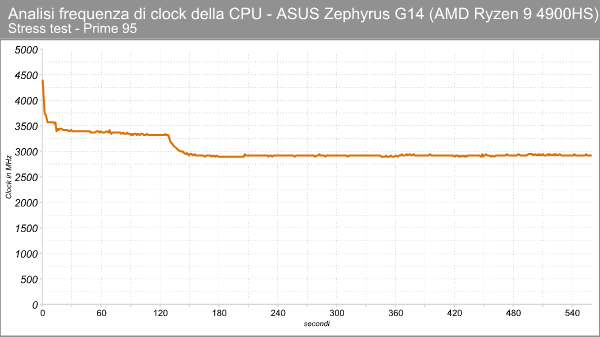
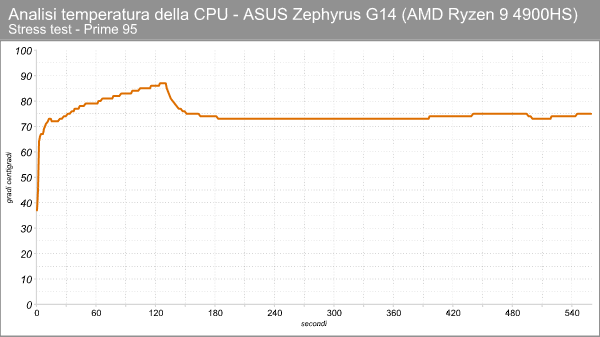
The cooling system starts operating helping the heat dissipation, without however an evident incidence in terms of operating noise. We detected in this mode a noise of 39.5dB, in fact what we had already recorded for the Microsoft notebooks of the Surface Laptop 3 family in similar conditions of use.
Vega GPU integrated in Ryzen 4000
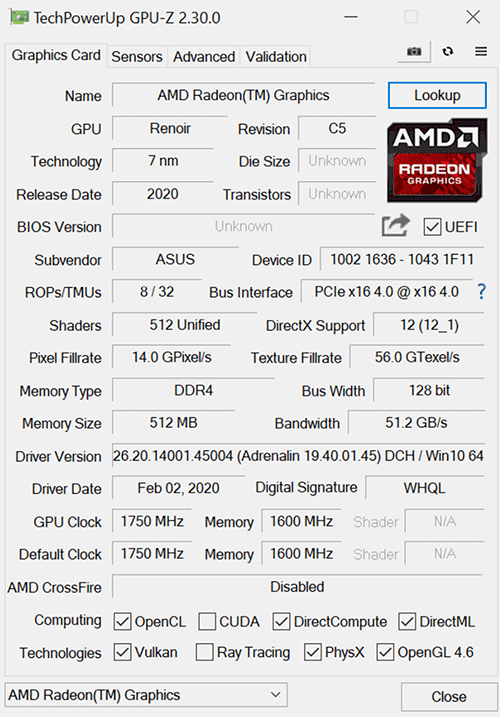
There are actually two video cards integrated in this notebook: the first is the discrete one, NVIDIA GeForce RTX 2060 Max-Q model, while the second is the Vega proposal integrated in the AMD Ryzen 9 4900HS processor. The latter operates when the system is not busy with 3D applications or that in general request the maximum processing power possible from the CPU side. The clock frequency of this component is 1,750 MHz; there are 8 Compute Units, for a total of 512 stream processors that allow to obtain very valid performance levels.
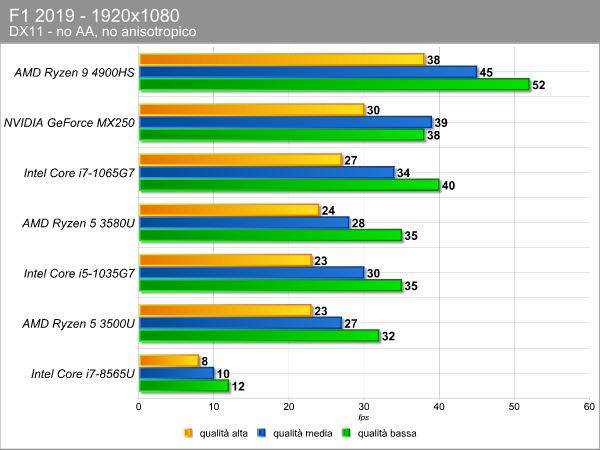
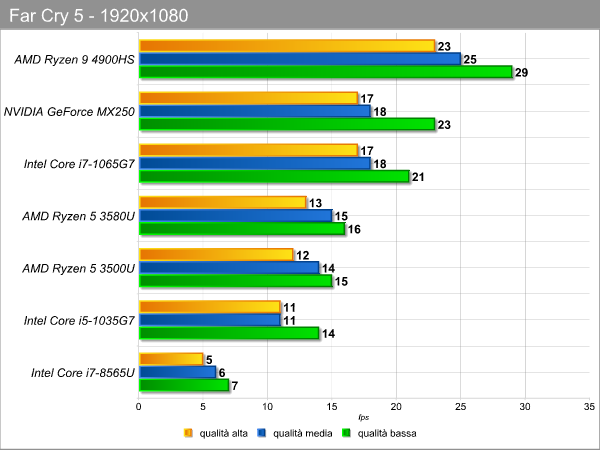
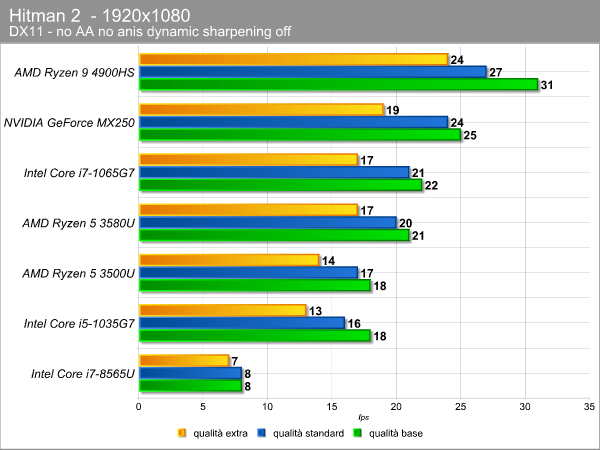
We managed to test those games that allow you to select which video card to use for rendering in the presence of more than one GPU in the system. Despite being limited by the resolution of 1920×1080, very high value for an integrated GPU, we highlight very convincing performances with these 3 titles at all the quality settings chosen. Not only is the GPU component integrated in the AMD Ryzen 9 4900HS processor faster than all the other integrated GPUs on the market that we have compared, but it allows you to obtain higher average frames per second than those of the dedicated NVIDIA GeForce MX250 card often used in thin notebooks to reach higher performance levels with games. We will certainly have the opportunity to return to the theme of the GPU performance integrated in the AMD Ryzen 4000 series processors as soon as we have notebooks equipped with H series CPUs and therefore completely dependent on the Vega GPU integrated in the processor.
GeForce RTX 2060 Max-Q: always very high fps
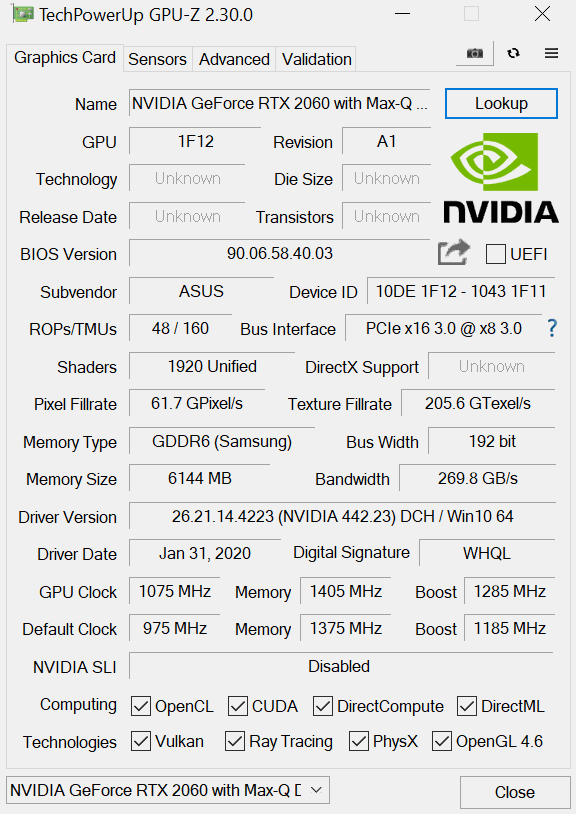
In Zephyrus G14 we find an NVIDIA GeForce RTX 2060 Max-Q video card, with options for the GeForce GTX 1660 Ti, GeForce GTX 1660 and GeForce GTX 1650 models depending on the version of the notebook. The technical specifications of this version are the same as the standard model in terms of the number of CUDA cores, equal to 1,920; the clock frequencies change which are lower due to the need to contain the overall consumption at full load. For the 6 Gbytes of video memory, the clock frequency is 1,400 MHz, for an effective value of 11 Gbps: by way of comparison, the GeForce RTX 2060 cards use 14 Gbps GDDR6 memories.
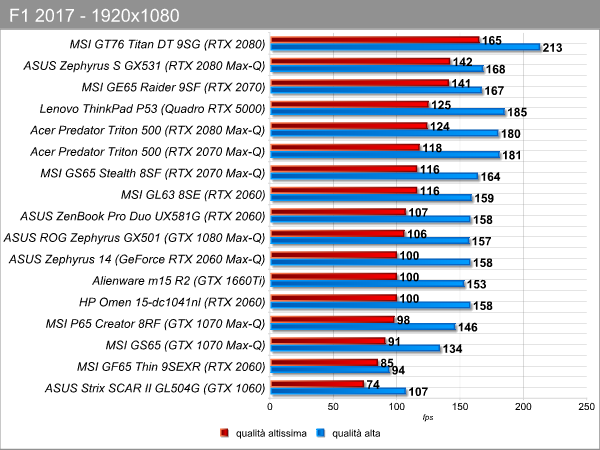
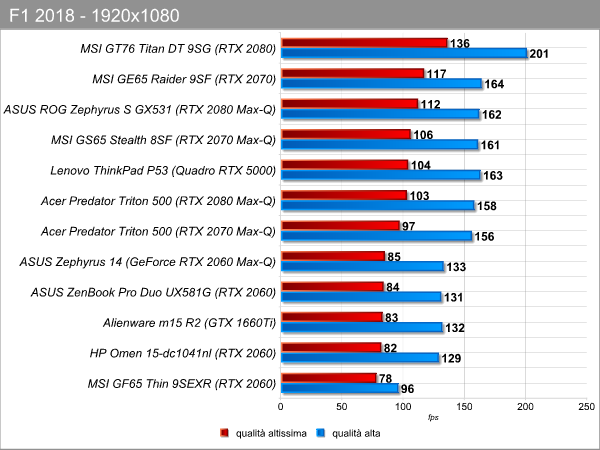
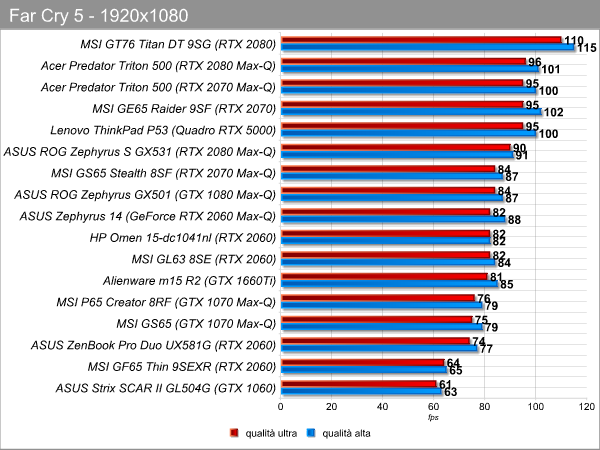
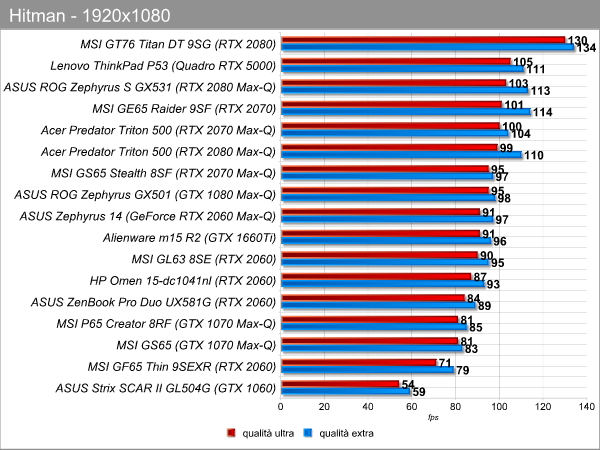
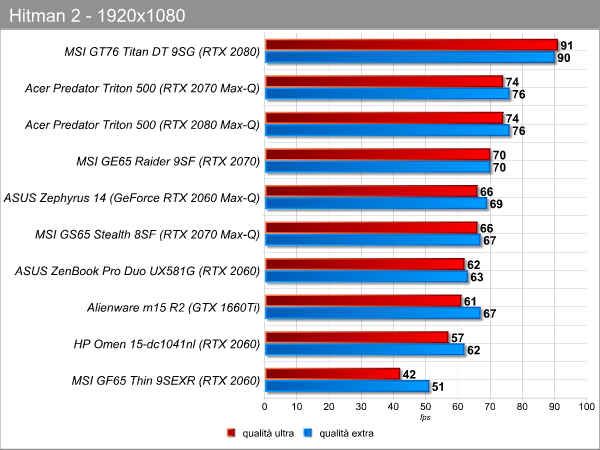
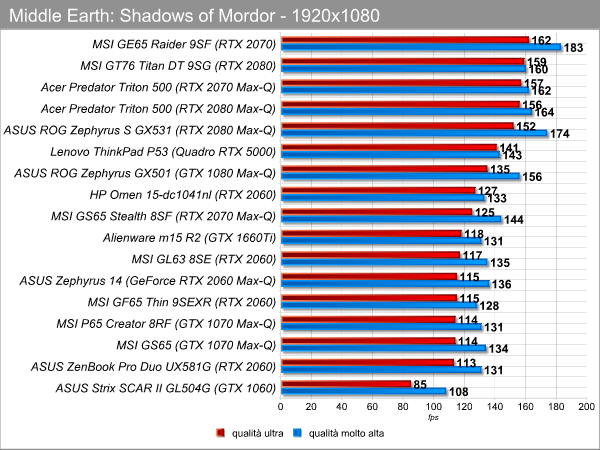
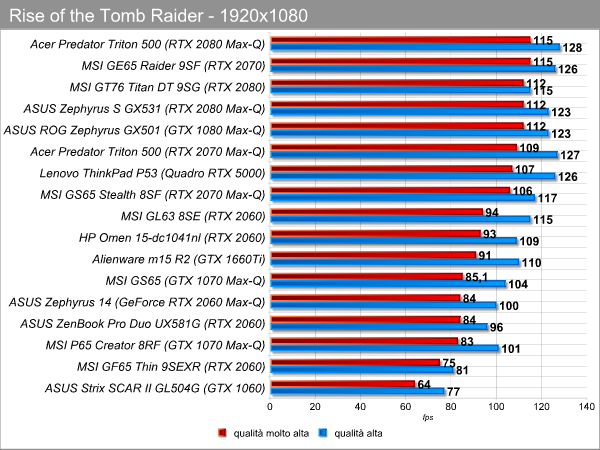
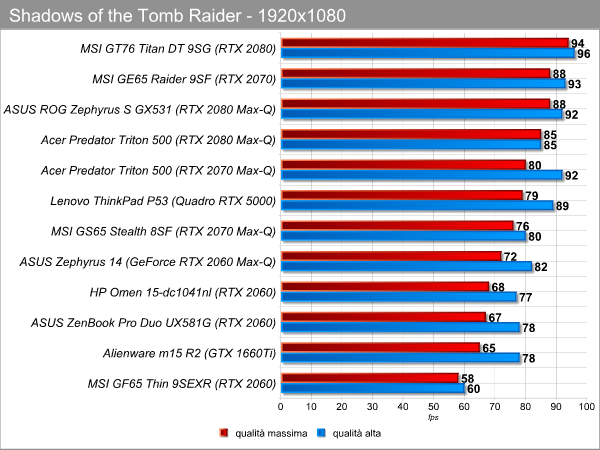
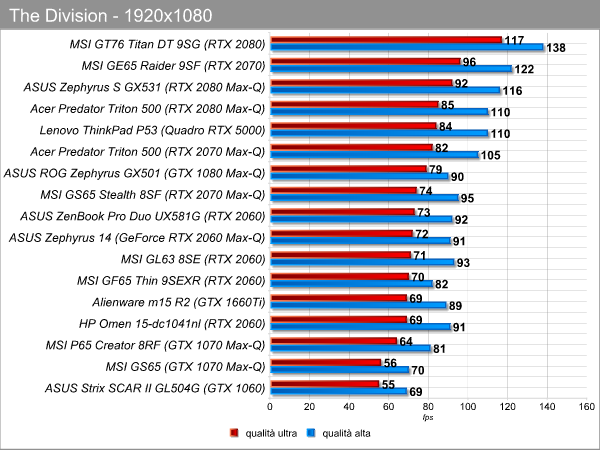
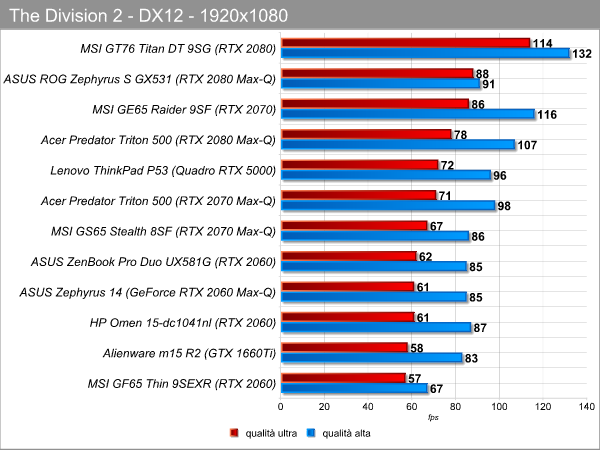
The processing power provided by the NVIDIA GeForce RTX 2060 Max-Q video card integrated in the ASUS Zephyrus G14 notebook is such as to ensure frames per second always adequate for full playability. The combination between this GPU and the resolution of 1920×1080 pixels reveals from this point of view an ideal mix, capable of ensuring average fps more and more adequate. We also note how the performance of this notebook is in fact mirrored to that of other notebooks based on GeForce RTX 2060 non Max-Q GPUs: the clock frequencies of the GPU are the same, with the main difference represented by the video memory clock which is of 14Gbps against 11Gbps of the Max-Q model. The direct consequence of this is that the bandwidth of the video memory clocked at 11Gbps, at the resolution of 1920×1080, is more than enough to prevent this component from being the bottleneck to video game performance.
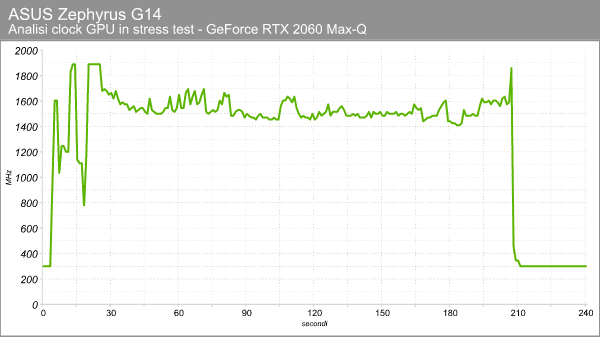
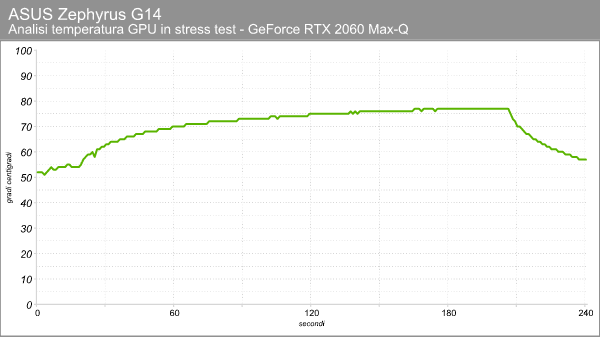
During full load use, the GeForce RTX 2060 Max-Q GPU goes well beyond 1,200 MHz of the boost clock frequency indicated by NVIDIA in the specifications: on average we are around 1,600 MHz, with some peaks at higher values. All this registering an operating temperature of the GPU, during the execution of 3D applications, which remains under control stabilizing around the value of 80 °.
Internal construction engineered to ensure silent operation
The cooling of the processor and GPU provides a pair of fans, mounted on the two sides of the top of the notebook as we can see from the image. They suck air from the two slits on the back at the base of the screen to blow it outside from the two openings on the sides,
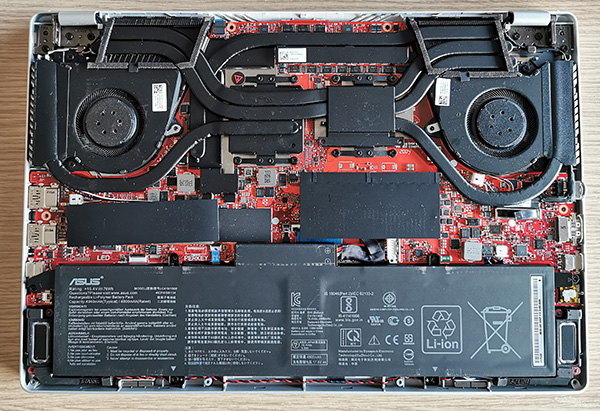
Looking at the dissipation structure, we notice the presence of various heatpipes that connect processor, GPU and video memory to radiators used for cooling; the latter are then hit by the air moved by the fans. The result, as shown, is an overall very silent operation in consideration of the computing power offered: only by using the GPU at full load does the noise make itself heard more markedly, touching the detected 52dB under stress in the most demanding conditions of use 20cm from the keyboard. ASUS Zephyrus G14 is overall a silent notebook, considering what it offers and its small size.
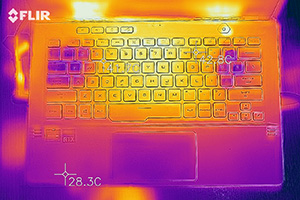
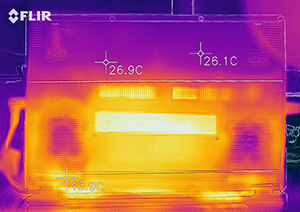
The thermal camera allows you to highlight how it is the keyboard area, and the corresponding one below, to reach the highest temperatures when CPU and GPU are exploited to their maximum power for long periods of time. The values are by no means such as to create problems in use or to cause discomfort on contact with the fingers. Note the two areas in correspondence of the fans, with a surface temperature lower than the surrounding ones due to the movement of the air.
AMD Ryzen 9 4900HS: 8 mobile but very powerful cores
Let's now pass to the AMD Ryzen 9 4900HS processor, the processing heart of this Zephyrus G14: in the presence of 8 cores and the high clock frequencies of which it is capable, they allow to wait very interesting values in comparison with the other notebooks previously tested on these pages.
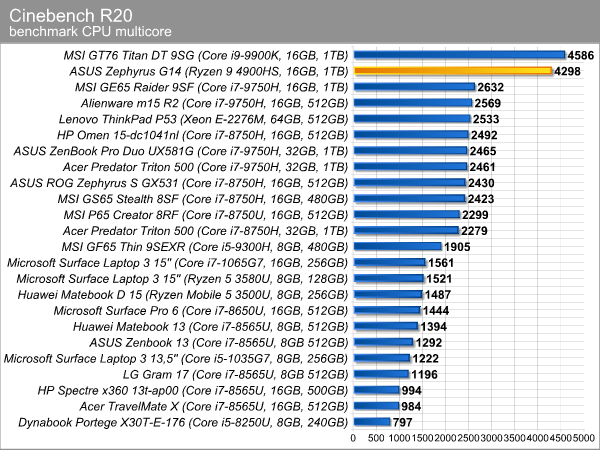
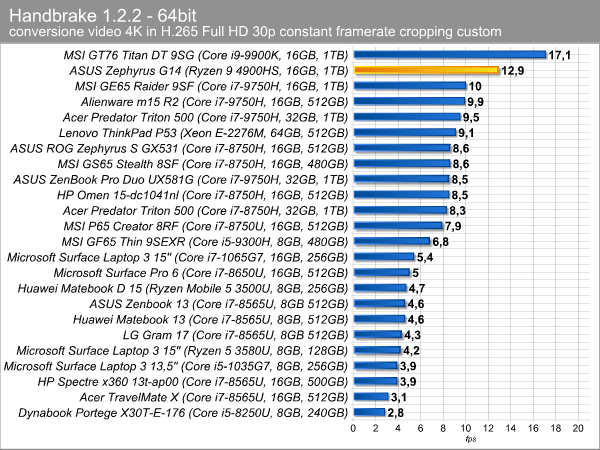
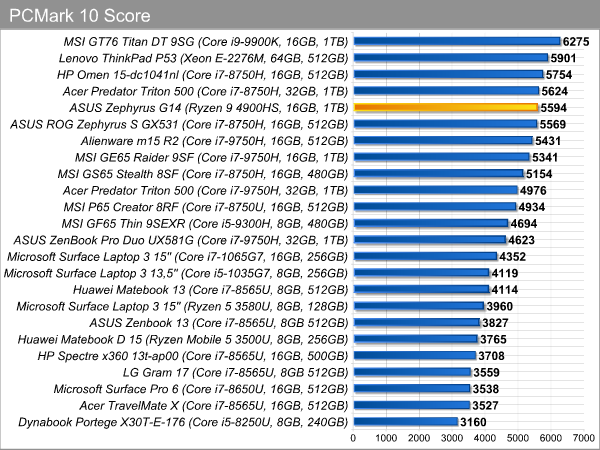
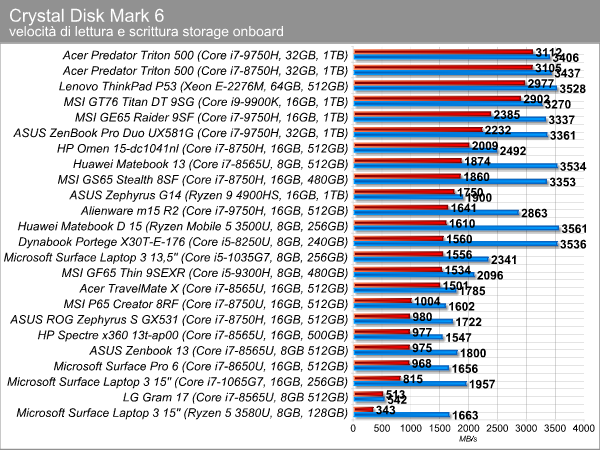
The performance offered by the AMD Ryzen 9 4900HS processor is among the highest, with both the efficiency of the Zen 2 architecture and the presence of 8 processing cores. It will be interesting to make a comparative evaluation with the Intel Core processors of the tenth generation of the H family, proposed with TDP equal to 45 Watts that will be used for gaming notebooks with technical characteristics specular to those of proposals such as ASUS Zephyrus G14.
Let's now analyze the performance of the AMD Ryzen 9 4900HS CPU in comparison with Intel and AMD models intended for desktop systems. This analysis allows us to better position the new mobile CPU on a pure performance level, making it better to understand what a great step forward it represents in terms of processing power offered by a notebook system.
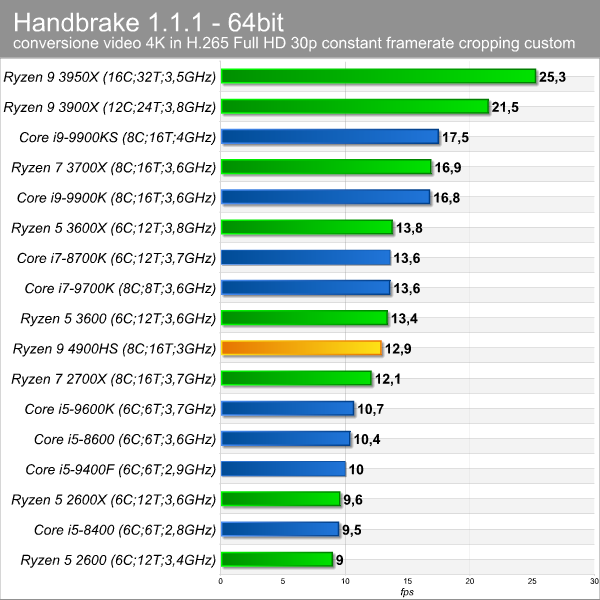
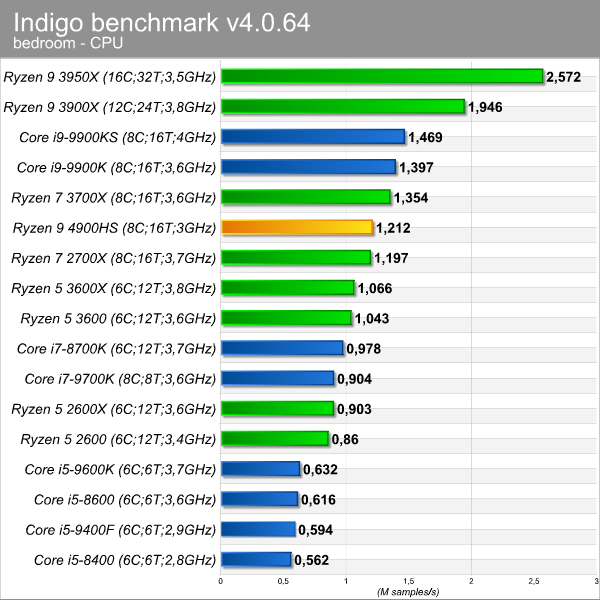
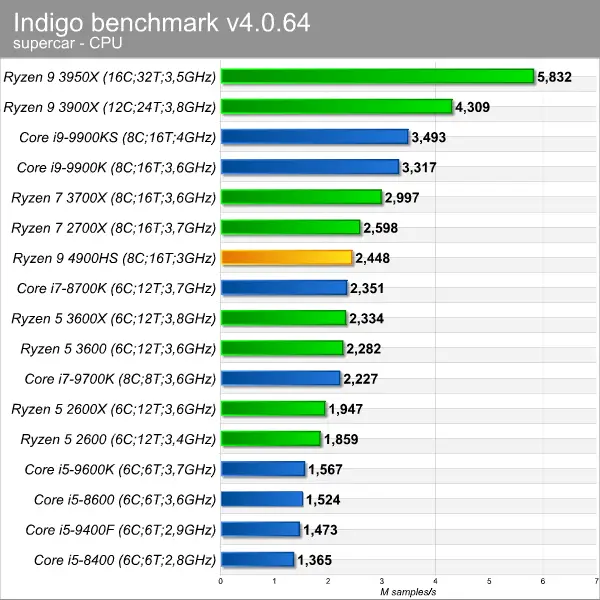
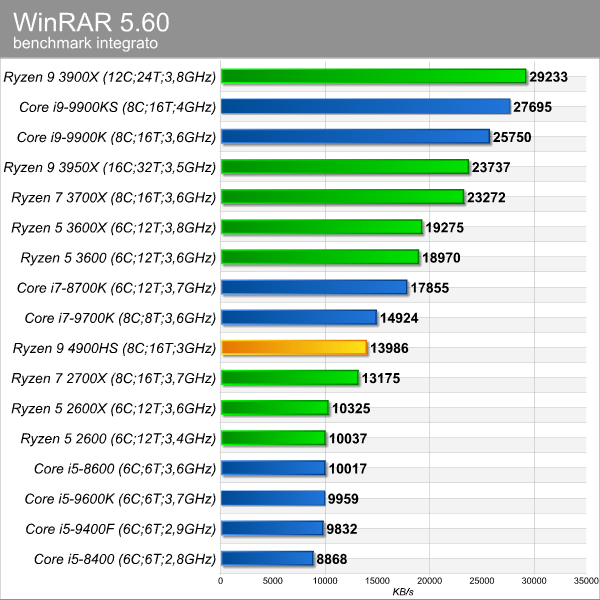
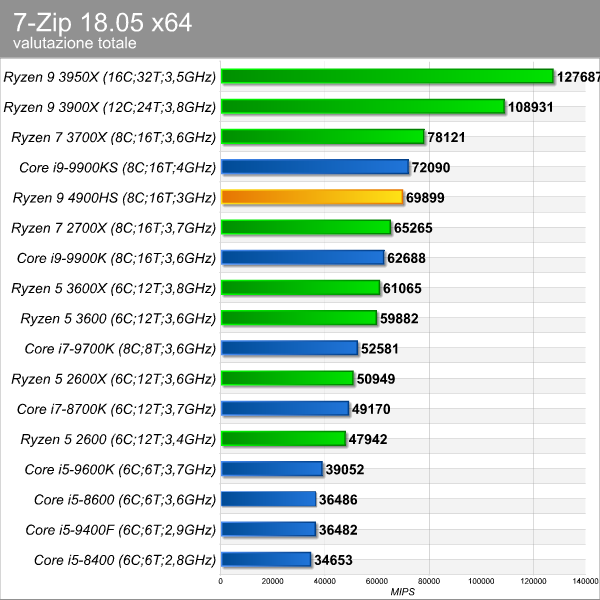
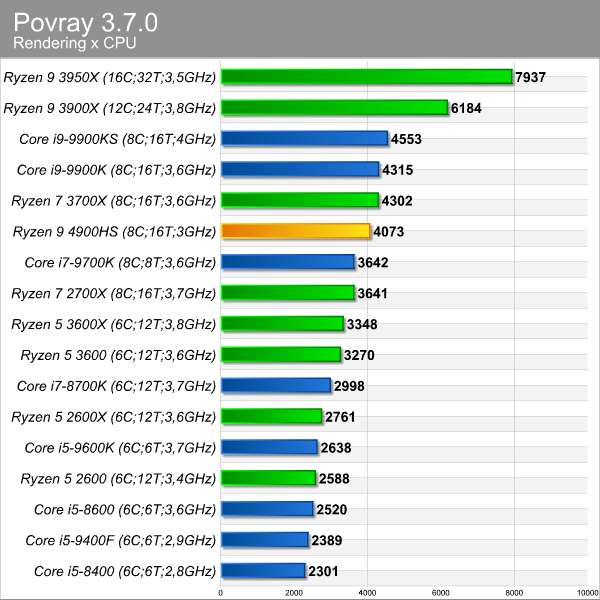
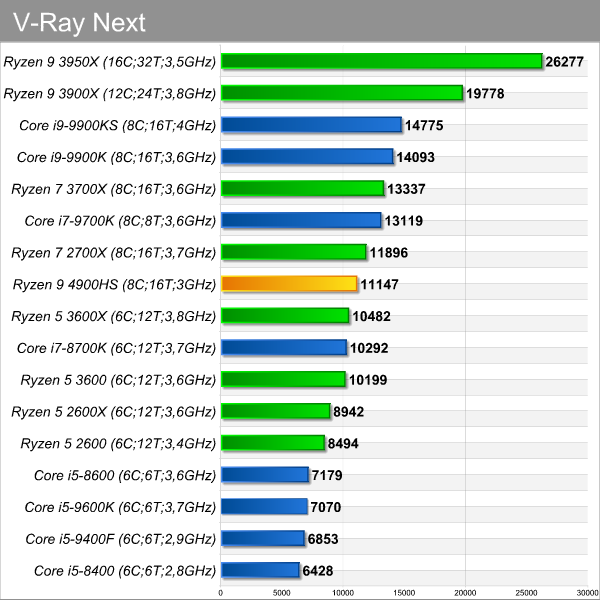
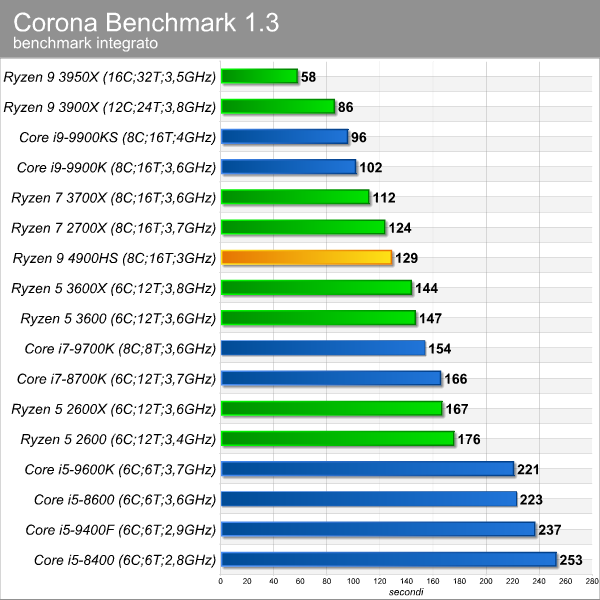
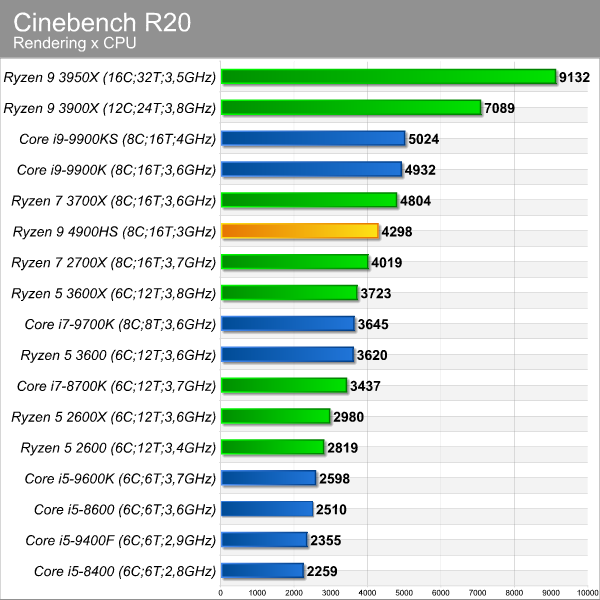
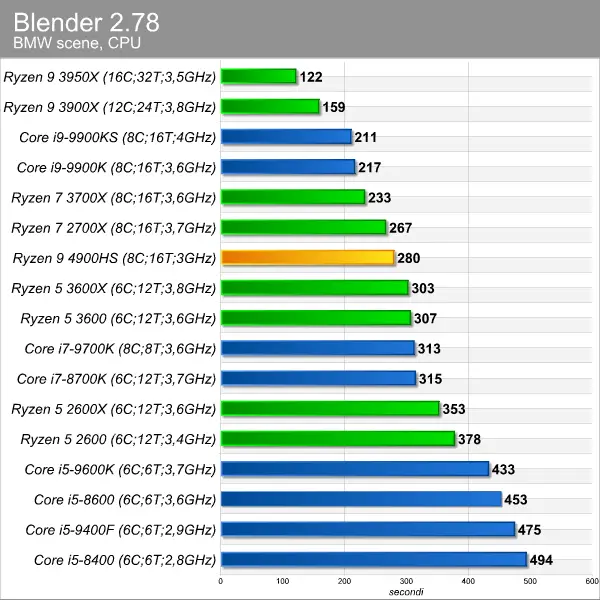
Looking at these results, you can understand the scope of the AMD Ryzen 4000 processors in notebook systems as well as the overall efficiency of the Zen 2 architecture. The results obtained are very close to those of the AMD Ryzen 7 3700X and Ryzen 7 2700X processors, both with 8 cores and 16 threads based on Zen 2 and Zen + architecture respectively. These two processors boast much higher base clock frequencies than those of the Ryzen 9 4900HS model, by virtue of their TDP which is equal to 65 Watts for the 3700X model and 105 Watts for the 2700X model against the only 35 Watts of the new mobile CPU of the 4000 family. Thinking about using a notebook like Zephyrus G14 as an alternative to a high-end desktop system, in terms of CPU component performance, is an option that is definitely within the reach of the passionate user and that does not bring, data in hand, to limits regarding computing power.
Record autonomy thanks to a large battery
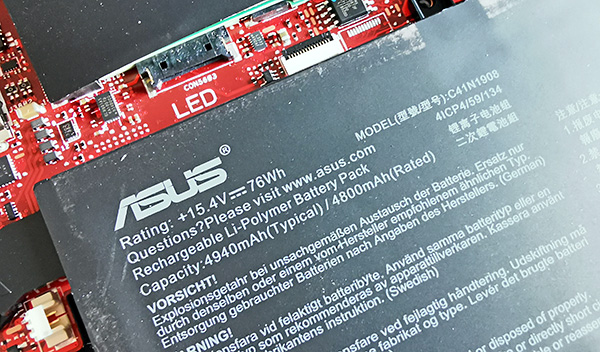
ASUS has integrated a large 76Wh battery into the Zephyrus G14, despite the overall size of the notebook being far from high. The battery occupies about 40% of the internal volume of the notebook and is directly responsible, together with the efficiency of the Ryzen 9 4900HS processor, for excellent overall autonomy.
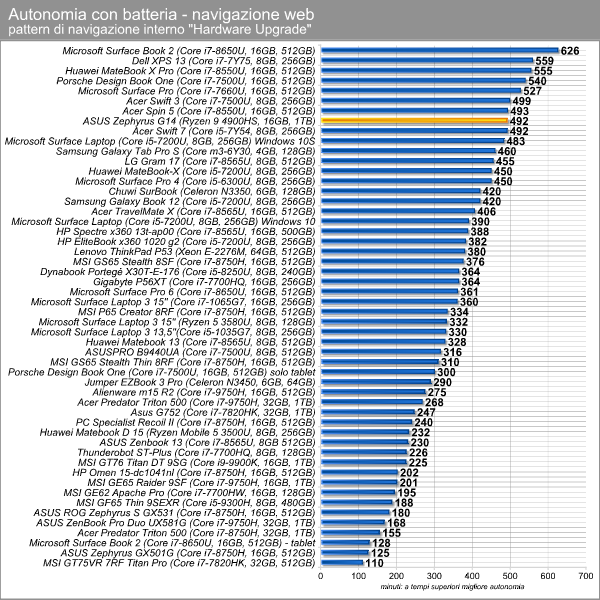
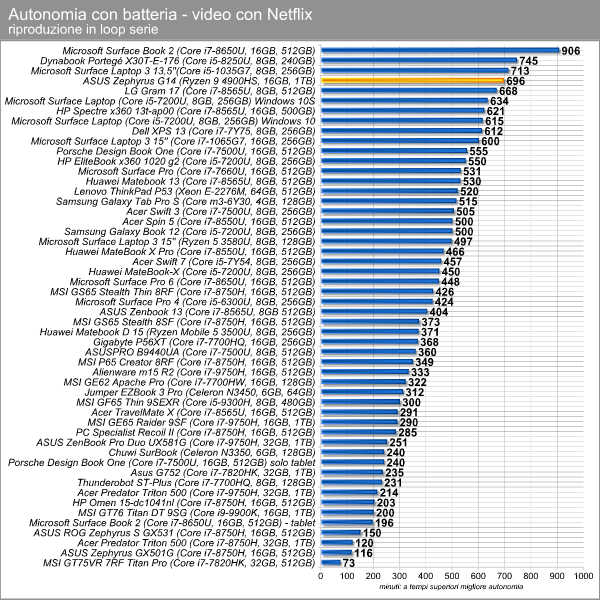
Over 8 hours in the web browsing test and more than 11 hours in the video streaming playback test with Netflix: these are the data that we recorded in our usual battery life tests with Zephyrus G14. Not only a lot of processing power, both from the CPU side and from the GPU side, for this ASUS notebook intended for gamers and enthusiasts but also the guarantee of being able to use it for personal productivity as for entertainment disconnected from the power outlet for a long time .
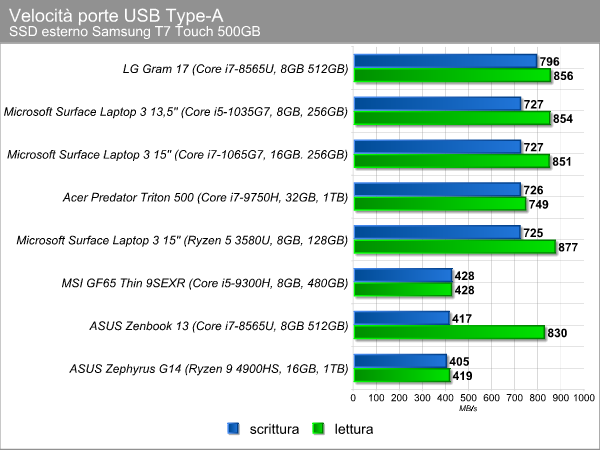
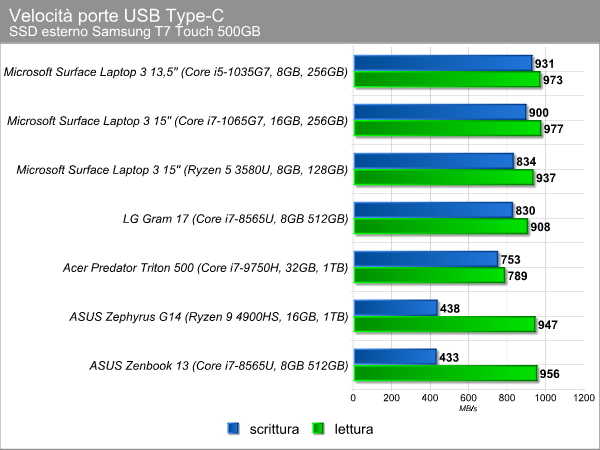
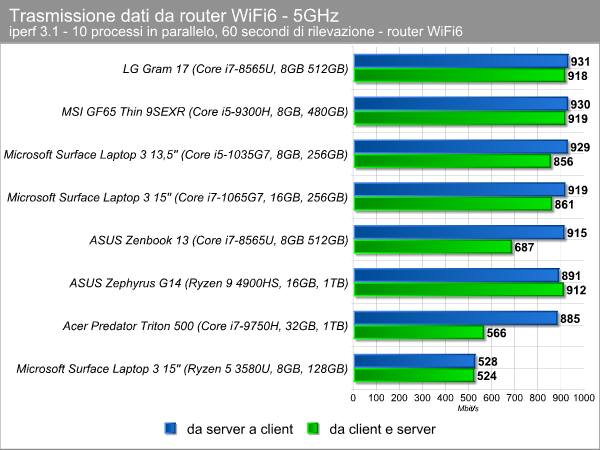
The tests related to the speed of data transmission via USB ports and WiFi network show no problems; the results with USB Type-A connection are not particularly high both in writing and in reading, while the situation improves with Type-C interface at least in reading. Finally, the transfer data via WiFi6 router are in fact aligned with those of Intel notebooks with the 10th generation Core CPU of the Ice Lake family.
Display: 14 inches IPS and Full HD of good quality
The 14-inch panel on this laptop has a native Full HD resolution of 1920×1080 pixels for a density of 138 pixels per inch. It is an IPS panel with a matte finish that strongly limits the onset of reflections on the screen: the panel is set in rather thin bezels that help to contain the overall size of the laptop.
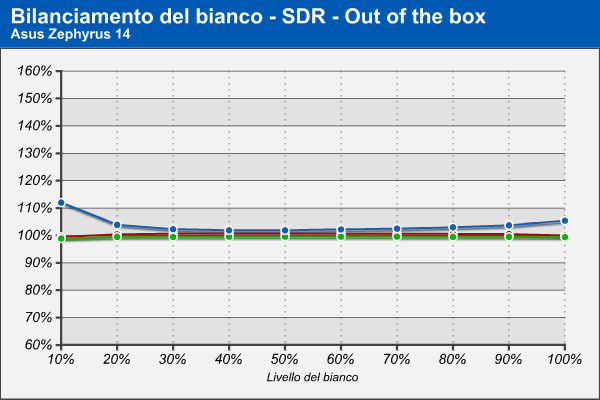
The first analysis that we are going to comment, as usual, is that which investigates the balance of the RGB components along the entire gray scale and which allows us to verify whether the subpixels of the screen all operate adequately. In this case we find a very good behavior for most of the scale, with only a little excess of blue in the area of deep blacks and low lights, where, however, the perceptual feedback is almost nil.
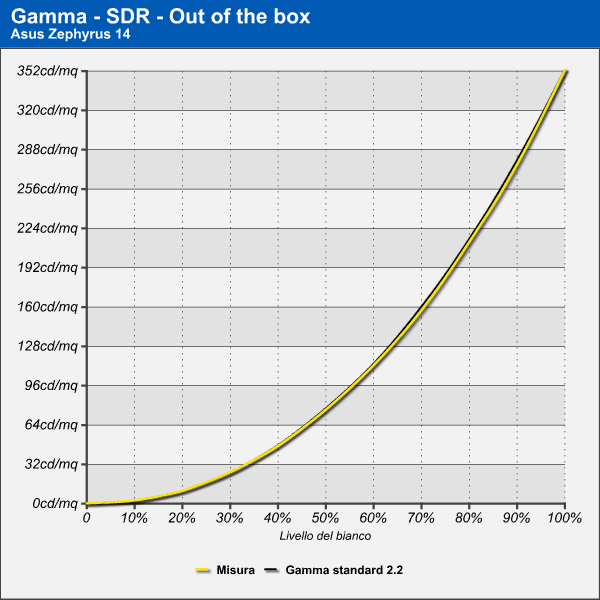
We remain in the tonal area and continue the analysis of the gray scale with the measurement of the gamma curve, which for this panel is adhering quite convincingly to the reference 2.2 and thus returning a correct tonal progression. The maximum luminance recorded is 352 candles per square meter, a value that should allow easy use of the panel even in situations of strong lighting. The resulting contrast ratio is a good 1200: 1.
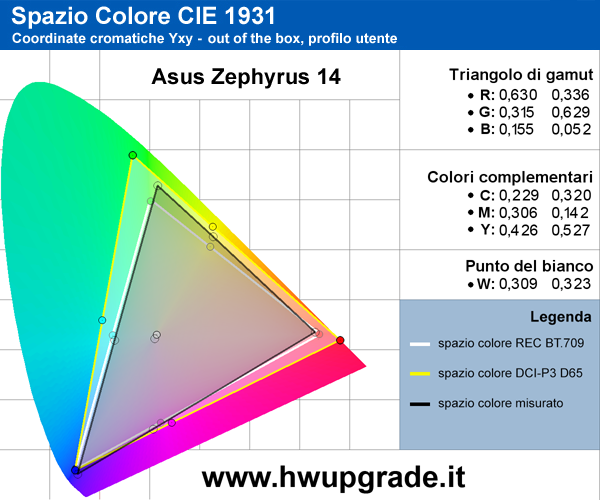
Let's now pass to the chromatic analysis where we find, colorimeter in hand, a gamut triangle of good extension that slightly exceeds also the reference REC.709 in the green and yellow zone. We do not reach the extensions of a triangle P3, but we are still faced with a very convincing behavior. The white is quite precise, only slightly affected by the behavior already observed during the RGB analysis.
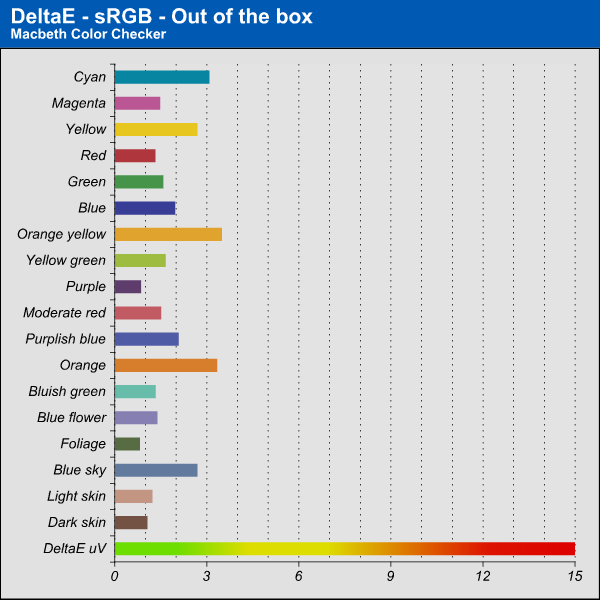
The analysis of color fidelity, which in a certain sense summarizes everything we have analyzed above, shows us a panel that in most cases manages to remain below the Delta E 3 value, which we remember to be the limit after the which the human eye can already perceive the difference between two very similar colors. It follows that we are faced with a panel that performs well and offers good versatility of use: not only the videogame field and the use of content but also the production of photo / video / graphics at a prosumer level becomes possible.
Ryzen 4000 for notebook amazes and convinces
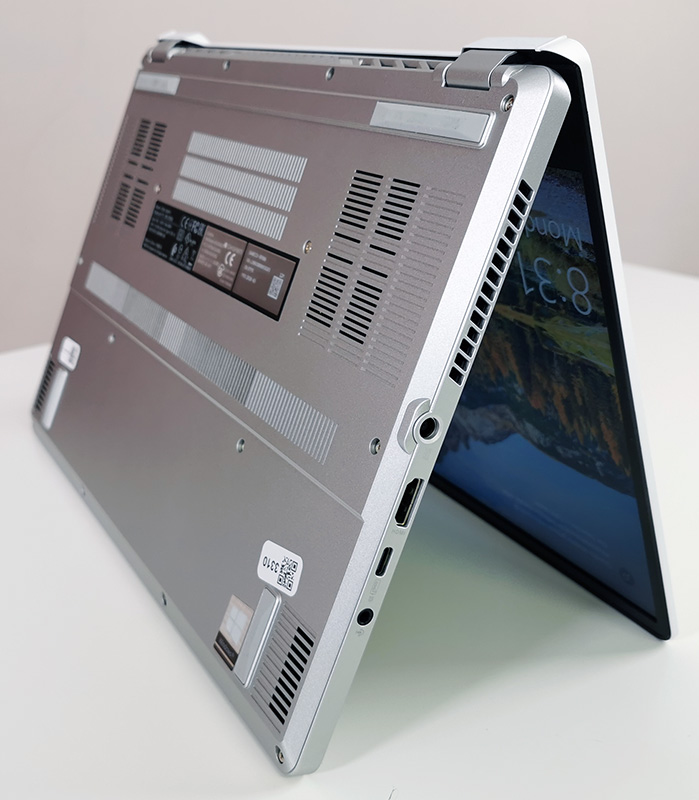
With the Ryzen processors of the 4000 AMD series, it is a candidate to gain a market share higher than that collected to date in the notebook sector, mirroring what has been done in recent years with Ryzen CPUs for desktop systems. The technical characteristics of these processors, both for the CPU component and for the integrated GPU, allow the development of notebooks that combine power and autonomy of battery operation.
The Ryzen 9 4900HS processor, which equips the ASUS ROG Zephyrus G14 notebook tested here, is a solution that not only stands out in comparison with notebook systems of similar overall consumption but is also capable of doing better than many desktop processors now on the market, characterized from TDP well above. It will be interesting to evaluate the potential of the Ryzen 4000 processors of the U family, proposed with a 15 Watt TDP intended for use in lighter and thinner notebooks.
[HWUVIDEO=”2912″]ASUS Zephyrus G14: 8 cores with AMD Ryzen 4900HS[/HWUVIDEO]
The ASUS ROG Zephyrus G14 laptop is a very original solution in terms of design and technical characteristics. It implements powerful components that ensure an average performance level of excellence, combining this with a small chassis, silent operation and an autonomy that is significantly higher than what is typically expected from a gaming notebook. The absence of a webcam integrated in the frame of the screen is surprising, a useful accessory in these times of videoconferencing with anyone: ASUS offers it as an accessory, a choice dictated by the target audience of this system which is that of the videogame player.





